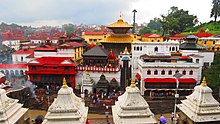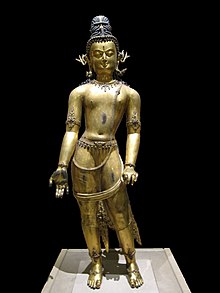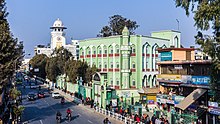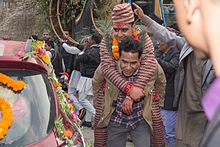Religion in Nepal
hideThis article has multiple issues. Please help or discuss these issues on the talk page. (Learn how and when to remove these template messages)
|
Religion in Nepal (2011)[1]






Religion in Nepal encompasses a wide diversity of groups and beliefs.[2] Nepal is a secular nation and Secularism in Nepal under interim constitution (Part 1, Article 4) is define as 'religious, cultural freedom, along with the protection of religion, culture handed down from time immemorial (सनातन)' that is "the state government is bound for protecting and fostering Hindu religion" while maintaining "religious" and "cultural" freedom throughout the nation as fundamental rights.[3][4][5] Federal Democratic Republic of Nepal's most popular practiced religions are Hinduism along with Buddhism which accounts for 81.3% & 9.04% of the overwhelming population of the nation as of 2011 respectively. According to a survey, Nepal is the most religious Hindu-majority country throughout the world, with most of the important Hindu pilgrimage centers concentrated in this country. Nepal is also the birthplace of Gautama Buddha because of which Buddhism has a very special place in the country and is often intertwined with Hinduism among some communities.[6][7] It is a multi-cultural, multi-ethnic, multi-lingual and multi-religious nation through democracy.[8][9] Shiva is widely regarded as the guardian deity of Nepal.[10] Nepal is home to the world-famous Pashupatinath Temple, a UNESCO World Heritage Site, where Hindus throughout the world come for pilgrimage purposes. According to Hindu mythology, the goddess Sita of the epic Ramayana was born in the Mithila Kingdom of King Janaka Raja.[11] The national animal of Nepal is the cow,[12] which is considered a sacred animal in Hinduism.[13] Because of this, the slaughter of cows is illegal in Nepal.[14]
Freedom of religion is also guaranteed by the Nepali constitution. Forced conversion from Hinduism to other religions is prohibited by law, especially when money is used as a direct or indirect inducement to convert, but anyone can convert from one religion to another as an exercise of their own volition. Nationalists have sometimes protested against secularism – they want Nepal to be reinstated as a Hindu theocratic state.[15] Prior to the movement for democracy in early 2006 and the sacking of King Gyanendra in 2008, the country was officially a Hindu kingdom, and the constitution still protects and fosters the Hindu religion. Hinduism is the majority religion in Nepal, and profoundly influences its social structure and politics, while Buddhism (Tibetan Buddhism) is practiced by some ethnic groups (such as the Newar people) in forms which are strongly influenced by Hinduism; Kiratism is the grassroots native religion of the population belonging to the Kirati ethnicity. Small populations, especially in eastern Nepal, adhere to Islam, Christianity, Sikhism, Jainism, Bön, and the Bahá’í Faith.
History[]

Nepal has had Hindu dharma and Buddhist dharma from the beginning of recorded history in the area, though it originally had only Kiratism and other tribal religions; Islam was introduced to the nation around the 11th century with the arrival of Muslim invaders. Christianity was introduced to the country in the 1700s when Catholic friars entered the Kathmandu valley and Christian missionaries are active throughout the country. Sikhism came to Nepal during the 18th century and spread throughout Nepal, and Jainism came to Nepal during the 19th century but spread only to Kathmandu and some districts of Nepal. Both Sikhism and Jainism are an integral part of Nepal now and both constitute a significant role in Nepalese identity and culture, though they are Indian-born Dharmic religions.
Religious tolerance can be found in royal orders dated Falgun Sudi 12, 1884 V.S. issued by the Hindu Shah monarch Rajendra Bikram Shah under the premiership of Bhimsen Thapa to Buddhist monks in the Kingdom of Nepal:
Our father (i.e. King Girban) has issued a copper plate inscription declaring that nobody shall harass you so long as you observe traditional religious practices (dharma). We hereby reconfirm that order.
According to the 2011 census, 81.3% of the Nepalese population is Hindu, 9.0% are Buddhist, 4.4% are Muslim, 3.0% are Kiratist (indigenous ethnic religion), 1.4% are Christian, 0.1% are Sikhs, 0.1% are Jains and 0.7% follow other religions or no religion.[1] This varies from the 2001 census, where 80.62% percent of Nepalese were Hindu, 10.74% were Buddhist, 4.20% Muslim,[17] 3.60% Kirant (an indigenous religion), 0.45% Christian, and 0.4% were classified as other groups such as Bön. In 1971 Hindus were 89.4% of the population, Buddhists 7.5%, and Kirants statistically 0%. However, statistics on religious groups are complicated by the ubiquity of dual-faith practices, particularly among Hindus and Buddhists.
The geographical distribution of religious groups in the early 1990s revealed a preponderance of Hindus, accounting for at least 87% of the population in every region. The largest concentrations of Buddhists were found in the eastern hills, the Kathmandu Valley, and the central Tarai; in each area about 10% of the people were Buddhist. Buddhism was more common among the Newar and Tibeto-Nepalese groups. Among the Tibeto-Nepalese, those most influenced by Hinduism were the Magar, Sunuwar, and Rai peoples. Hindu influence was less prominent among the Gurung, Limbu, Bhote, Tamang and Thakali groups, who continued to employ Buddhist monks for their religious ceremonies. Since both Hinduism, as well as Buddhism, are Dharmic religions, they usually accept each other's practices and many people practice a combination of both. In 2015, a new constitution was adopted and granted equal rights to all religions in Nepal. However, influencing others to change their religion is prohibited.[18] There has been political pressure from India's Hindu party that it should become a Hindu government again but it has received a negative response from the Nepalese government.
Nepal's constitution doesn't give anyone the right to evangelise or convert any person to another religion. Nepal also passed a more stringent anti-conversion law in 2017.[19][20] The ban on evangelism has been protested by Christian groups in the country.[21]
Secularism[]
Nepal was declared as a 'secular state' in 2008 after the success of the people's movement of 2006 that saw the abolition of monarchy and formation of democracy as a criterion for running the nation on the path of equality, fraternity, freedom, justice and liberty.[22]
The five main provisions of Secularism in Nepal are as follows[23] -:
1) A clause stating that "Religious and cultural freedom, with the protection of religion and culture practiced since ancient times". This has questioned by some people who says that it indirectly favours Hinduism.[24]
2) Proselytising remains illegal.
3) The critics says that the constitution discriminates against women in terms of passing on citizenship Rights and the citizenship policy were hotly debated during the drafting of constitution.[25]
4) The state and the judiciary are prohibited from discriminating against sexual and gender minorities. The constitution is the first in Asia to specifically protect the rights of lesbian, gay, bisexual and transgender communities.[26]
5) The rhododendron is the national flower, and the cow, which is an holy animal in Hinduism, remains the national animal after seeing off a charge from several lawmakers proposing the one-horned rhino.[27]
Demographics[]
| Religion | Population
% 1952/1954 |
Population
% 1961 |
Population
% 1971 |
Population
% 1981 |
Population
% 1991 |
Population
% 2001 |
Population
% 2011 |
|---|---|---|---|---|---|---|---|
| Hinduism | 88.87% | 87.69% | 89.39% | 89.50% | 86.51% | 80.62% | 81.34% |
| Buddhism | 8.59% | 9.25% | 7.50% | 5.32% | 7.78% | 10.74% | 9.04% |
| Islam | 2.54% | 2.98% | 3.04% | 2.66% | 3.53% | 4.20% | 4.39% |
| Kirat | N/A | N/A | N/A | N/A | 1.72% | 3.60% | 3.04% |
| Christianity | N/A | N/A | 0.02% | 0.03% | 0.17% | 0.45% | 1.41% |
| Others/Unspecified | 0.01% | 0.07% | 0.05% | 2.49% | 0.28% | 0.39% | 0.78% |
| Religion | Population | Percentage |
|---|---|---|
| Hinduism | 21,551,492 | 81.34% |
| Buddhism | 2,396,099 | 9.04% |
| Islam | 1,162,370 | 4.39% |
| Kirat | 807,169 | 3.04% |
| Christianity | 375,699 | 1.41% |
| Prakriti (Nature Worship) | 121,982 | 0.46% |
| Bon | 13,006 | 0.04% |
| Jainism | 3,214 | 0.01% |
| Bahá'í | 1,283 | 0.01% |
| Sikhism | 609 | 0.01% |
| Others/Unspecified | 61,581 | 0.25% |
| Total | 26,494,504 | 100% |
Hinduism in Nepalese culture[]


According to Nepalese theology Lord Brahma, Vishnu and Shiva had come to Nepal in the form of deer.[30]
Establishment of Nepal by Ne Muni[]
King Muni used to perform religious ceremonies at Teku, the confluence of the Bagmati and Bishnumati rivers.[31] He selected Bhuktaman to be the first king in the line of the Gopal (Cowherd) Dynasty.[31] The Gopal dynasty ruled for 300 years. Yakshya Yadav was the last king of this dynasty. The Kirat Dynasty ruled for 550–800 years. The first king of Kirat Yalambar and Gasti was the last king of this dynasty. The Licchavi dynasty ruled for 200–350 years. The Malla Dynasty ruled for 400–600 years. The Shah dynasty ruled for 300 years. However, this mythology can be challenged as no such name as Ne exists in Nepali or other Sanskrit-derived languages.
Flag of Nepal[]
The current flag was established in 1962 and depicts a white moon and crescent shape emitting eight rays above a white sun emitting 12 rays.[32]
See also[]
- Buddhism in Nepal
- Hinduism in Nepal
- Gurung shamanism
- Islam in Nepal
- Nepali Muslims
- Judaism in Nepal
- Christianity in Nepal
- Roman Catholicism in Nepal
- Jainism in Nepal
- Bahá'í Faith in Nepal
- Sikhism in Nepal
- Irreligion in Nepal
References[]
- ^ Jump up to: a b Statistical Yearbook of Nepal - 2013. Kathmandu: Central Bureau of Statistics. 2013. p. 23. Retrieved 13 December 2015.
- ^ Interim Constitution of Nepal - Equal Rights Trust
- ^ "The Interim constitution of Nepal (2015), privileges Hinduism as the state sponsored religion". scroll In.
- ^ https://www.lawcommission.gov.np/en/archives/category/documents/prevailing-law/constitution/constitution-of-nepal
- ^ https://www.inspiringvacations.com/au/nepal-tours/insight-articles/a-history-of-religion-in-nepal/965
- ^ "South Asia :: Nepal — The World Factbook - Central Intelligence Agency". www.cia.gov. Retrieved 2019-07-01.
- ^ "Same Same But Different: Religion in Nepal". Inside Himalayas. 2018-06-20. Retrieved 2019-07-01.
- ^ "Is Nepal a Hindu state or secular?". ucanews.com. Retrieved 2019-07-01.
- ^ "Nepal Adopts New Constitution, Becomes a Secular State: 5 Facts". NDTV.com. Retrieved 2019-07-01.
- ^ "Visit the "Guardian Deity of the Himalayan Country" Pashupatinath". Advice, Blogs & Stories. Retrieved 2019-10-09.
- ^ mountainmartpr (2017-06-29). "10 UNESCO World Heritage Sites of Nepal". Adventure Holidays in Nepal. Retrieved 2019-07-01.
- ^ "Cow becomes national animal of Nepal". News18. Retrieved 2019-07-01.
- ^ "Sanctity of the cow | Hinduism". Encyclopedia Britannica. Retrieved 2019-07-01.
- ^ Ojo, Kehinde (2 November 2018). "Nepal's Cattle Slaughter Ban: Impacts on Dairy Producers' Profit". AGRILINKS. Retrieved 1 July 2019.
- ^ "Religious freedom in Nepal 'teetering on the edge'". World Watch Monitor. Retrieved 2019-07-31.
- ^ Regmi 1987, p. 18.
- ^ "MUSLIMS of NEPAL: Becoming an assertive minority". October 13, 2007.
- ^ Ochab, Ewelina U. "Nepal's Protection Of Religious Freedom On Downward Spiral". Forbes.
- ^ "Nepal's new law puts squeeze on Christians - UCA News". ucanews.com. Retrieved 2020-12-12.
- ^ "Nepal: Nepal: Bill criminalises religious conversion". www.csw.org.uk. Retrieved 2020-12-13.
- ^ Shellnut, Kate (25 October 2017). "Nepal Criminalizes Christian Conversion and Evangelism". Christianity Today. Retrieved 14 December 2020.
- ^ https://www.outlookindia.com/website/story/world-news-nepal-party-demands-govt-to-declare-country-as-hindu-state-revoke-secularism/325816
- ^ https://www.ndtv.com/world-news/nepal-adopts-first-full-democratic-charter-today-1219574
- ^ https://scroll.in/article/756609/nepals-new-constitution-comes-into-force-on-sunday-but-minorities-say-it-privileges-hindus
- ^ https://www.nepalitimes.com/banner/nepal-waits-for-an-unequal-citizenship-law/
- ^ https://www.hrw.org/news/2017/08/11/how-did-nepal-become-global-lgbt-rights-beacon
- ^ https://news.mongabay.com/2017/08/in-nepal-the-rhino-evokes-national-pride/
- ^ "Population Monograph of Nepal Volume II (Social Demography)" (PDF).
- ^ "Population Monograph of Nepal Volume II (Social Demography)" (PDF).
- ^ History of Nepal: With an Introductory Sketch of the Country and People of Nepal, Daniel Wright
- ^ Jump up to: a b The Ancient Period Archived 2008-05-24 at the Wayback Machine
- ^ "Flag of Nepal". Encyclopedia Britannica. Retrieved 2019-07-31.
Sources[]
- Regmi, Mahesh Chandra (1987), Regmi Research Series, 19, Regmi Research Centre
- Religion in Nepal
